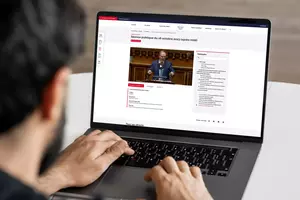A GENERAL PRESENTATION OF THE STRATEGIC COMPASS
The Strategic Compass is intended to be Europe's new defence doctrine that will match the EU's actual capabilities for action with its 'level of ambition' --which no doubt merits clarification--by defining the security and defence initiatives to take in the next ten years.
The EU's 'level of ambition'
The EU's 'level of ambition' includes a political aspect and a military aspect. It results from several texts drafted between 1999 and 2016.
Politically, the EU defined its level of ambition most recently in the EUGS and its implementation plan for security and defence. The EUGS mentions three strategic priorities for security and defence: react to external crises and conflicts , reinforce partners' capabilities , and protect the Union and its citizens .
Militarily, these objectives require 'full spectrum defence capabilities'. However, the EUGS has not led to a complete review of the types of operations that the EU and its Member States should be able to undertake. Thus, the EU's current military level of ambition is still derived from the TEU and headline objectives.
Under the TEU, the EU and its Member States should be able to carry out the following operations: 'joint disarmament operations, humanitarian and rescue tasks, military advice and assistance tasks, conflict prevention and peace-keeping tasks, tasks of combat forces in crisis management, including peace-making and post-conflict stabilisation' .
The Strategic Compass will comprise two main contributions: a shared assessment of the EU's threats and vulnerabilities and orientations and objectives for 2030, itself organised into four sections or "baskets" that will structure the EU's stance in its strategic environment: crisis management, resilience, capabilities and partnerships.
This work was formally launched by the Foreign Affairs Council in defence format on 17 June 2020. It will continue until the French Presidency of the European Union (FPEU) in the first half of 2022. The roadmap initially set out is on track to be respected:
1. June 2020: process launched
2. November 2020: threat assessment finalised
3. First half of 2021: discussion of resources and objectives, Member State contributions
4. Second half of 2021: synthesis with a view to a draft Strategic Compass
5. Political discussions and adoption of the Strategic Compass in March 2022
The drafting of the compass and related preliminary work is led by the High Representative/Vice-President of the European Commission, Josep Borrell, in close cooperation with the Member States. Converging Europeans around shared interests of defence and security is this work's main challenge.
• The threat assessment
Drawing up an inventory of threats means recognising that, perhaps not enemies, but at least adversaries and shared risks exist. Each Member State carries out this type of assessment regularly, as does NATO, which overhauls its 'Strategic Concept' every ten years or so.
However, this is the first time the European Union has conducted a deep, ten-year threat assessment. It was finalised on 26 November 2020. Based on contributions from intelligence services, this assessment is presented as a raw, classified, uncertified document produced by the European External Action Service (EEAS) and coordinated by the EU Military Staff (EUMS). 9 ( * ) It is divided into three parts: regional threats, transversal threats and threats to the EU. It also includes a prospective analysis component to identify how threats may evolve in the next five or ten years.
• Europe's response to these threats: setting guidelines and objectives for 2030
Member States were invited to present their contributions to the Strategic Compass in the first half of 2021. In February, the EEAS produced a scoping paper, an initial synthesis of the contributions organised into four baskets, intended to trigger new proposals in an iterative approach. This document was not publicly distributed either. At the core of the process, contributions in the form of 'non-papers' 10 ( * ) from certain Member States fuelled discussions in 'workshops', groups whose size varied depending on the subject discussed (by the non-paper) and which were made up of experts and representatives of Member States. These 'non-papers' were co-signed by varying numbers of Member States and then handed to the EEAS. The work's progress was punctuated by meetings of the Council of Ministers.
We can detail the content of each basket of the Strategic Compass as follows:
• internal and external crisis management : through this basket, the goal is to become a 'security provider' that proves to be more 'capable and effective' in the face of crises, to improve operational response and reactivity; here, we target European external missions and operations.
• resilience : this consists in securing access to shared assets (cyber, high seas, space), in assessing strategic vulnerabilities in defence and security (destabilisation, hybrid threats, threats to critical infrastructure, procurement chains, etc.), in strengthening mutual aid and solidarity between Member States (clauses in Articles 222 TFEU 11 ( * ) and 42.7 TEU 12 ( * ) ). This is a rather new chapter that seeks to protect shared values, institutions, tools and assets.
• developing capabilities : more specifically, developing the necessary civilian and military capabilities, improving the capability development process, promoting innovation and technological sovereignty, in keeping with the main capability tools implemented recently: Permanent Structured Cooperation (PESCO), the European Defence Fund (EDF, see above), etc.
• partnerships : this section covers the structure of cooperation with certain international organisations (UN, NATO, OSCE, African Union, ASEAN, G5 Sahel, etc.), the development of a strategic approach with third countries, and aid to EU partners so they can manage their own security.
The first two baskets set out the ambitions, the other two cover how they will be implemented. In other words, the first two baskets cover the objectives, the two others, the means.
There is a lot of overlap between these chapters, and there is no guarantee that the final product will be organised in this way. The EEAS will draft its synthesis in the second half of 2021. This draft Strategic Compass will be presented to the Foreign Affairs Council (Defence) in November 2021.
• Finishing the process
The Strategic Compass will be finalised with a view to adoption in March 2022, during the French Presidency of the Council of the European Union (FPEU) in the first half of 2022.
• In this work, the most salient specificities of the French approach , as signalled by the Ministry of Europe and Foreign Affairs, would be the following:
First, France does not intend to lock itself into a pre-established plan. For example, it drove making the issue of access to shared spaces (cyber, space, maritime spaces) a key one by triggering a workshop. Given the increase in risks, France feels that the European Union can help stabilise access to the spaces through normative action.
Secondly, it will be particularly attentive to how the compass is implemented. France will work to develop an implementation plan by 2030 with the presidencies that will follow: Czechia in the second half of 2022 and Sweden in the first half of 2023.
Finally, it is important to France that there is a good coherence between the Strategic Compass and NATO's Strategic Concept , which is being revised simultaneously, without the former conforming to the latter. Furthermore, while France wants to reaffirm the Allies' collective defence through NATO, it does not want the result to be a rigid 'sharing' of responsibilities that it considers dangerous, judging that it is up to countries that are members of both the EU and NATO to make sure their respective actions are coherent on a case-by-case basis.
I. A COMPASS FOR A FREE, STRONG AND PROTECTIVE EUROPE
A. RECONCILING ASSESSMENTS...
In the former Eastern Bloc, the Baltic States, Poland and Romania are focusing their attention on Russia and their expectations on NATO and the United States, rather than the EU.
Meanwhile, Southern Europe, France and Belgium are primarily sensitive to the risks of terrorism and migration, represented by the Sahel, the destabilising influence of Turkey's policies and the conflicts in Syria and Libya. Given NATO's overall refusal to take action in these theatres, these sensitivities come with the conviction that the EU must achieve its 'strategic autonomy', a concept on which Italy, Spain, and even part of Germany tend to agree.
Finally, countries like Austria, Ireland and Sweden traditionally feel distant from traditional threats; they do not belong to NATO and take a neutral stance militarily to security matters.
These divergences of view, which also apply to the attitude towards China and Libya, may seem deep, even insurmountable. But the stances that make up the range of the European Union's geostrategic sensibilities are not written in stone .
1. An accumulation of threats that calls for pooling
a) A growing number of increasingly varied and serious threats
Under the Trump administration, Europeans were stunned by the questioning of the automaticity of America's contribution through NATO to the collective security of its European members. Donald Trump explicitly made the United States' guarantee of the security of certain Member States via NATO dependent on their trade behaviour, using US protection as a bargaining chip - in particular against Germany in order to get it to reduce its exports.
At the same time, the Europeans were exposed to threats that were more specific, numerous and varied and which called for a common approach.
The risks of destabilising regional conflicts on the European Union's doorstep--such as in Syria, Libya and Nagorno-Karabakh--which could justify resorting to the CSDP as part of a crisis management operation, grew. A new assertiveness on the part of neighbouring middle powers-- Russia, Turkey, Iran--tensions over water and energy, climate change and food security are all circumstances that could precipitate or sustain such conflicts.
There were also proven aggressions, the nature of which fell within the scope of NATO's collective defence, but to which the Alliance struggled to provide a coordinated response because one of its members was involved: Turkey. Its attitude, its illegal actions to the detriment of Greece and Cyprus, against which France was the first to speak out vigorously, eventually led to a general condemnation, at least formally, within the EU.
There were other types of threats that replaced previous ones as they were identified, but which were not properly understood either by NATO or by the European Union, and that also called for organisation. The threat of terrorism, whether endogenous or exported, with its components of radicalisation and combat Islamism, is at the fore. The risk of migration causes concern, as do cyberattacks and misinformation, with active campaigns from Turkey, Russia and China. In general, China's rise has been accompanied by an increasingly intrusive and less friendly attitude that calls for as coordinated a response as possible.
Hybrid threats are a mix of the previous ones, resulting from security breaches that combine conventional and unconventional methods that can be diplomatic, military, economic or technical. They are ever-changing and hard to define, the work of regional or global powers seeking to extend their influence by using all the means at their disposal, including political and industrial espionage.
Under another angle, the use of chemical, bacteriological and nuclear weapons is also among the threats to the European Union within and outside its territory.
For around two years, 'resilience' issues such as access to contested spaces--especially maritime routes--and the control of investments in strategic sectors have aroused a fairly broad consensus. The health crisis, by highlighting the threats to the supply chain which could also seriously compromise the European Union's sovereignty, has put a spotlight on the notion of resilience.
As a counterpoint, the systemic threat posed by climate change, which has a direct effect in the Arctic and is already contributing to certain surges of migration in Africa, is also present but over a longer period of time, unfortunately with growing intensity each year.
b) The beginning of a certain convergence of views
The political context, if we focus on the Franco-German relationship, became favourable from 2017 onwards, with the conjunction of a French president, who was more pro-European than his predecessors, and a German chancellor who, under pressure from a Germany-demonising Trump, no longer hesitated to speak of the need for Europe to take control of its own destiny.
Europeans quickly came to agree that the environment had become more hostile than it had been in 2016, when the EUGS was established, which itself was quickly made obsolete since it had been published the same week as Brexit took place and six months before Trump's election. Its main virtue was that it brought about a moment of reconciliation (after strong divergences had emerged over the military intervention in Iraq) around a relatively low common denominator.
Consequently, they agreed on the need to give itself the means to be taken seriously and on the benefit of a new strategic document that would be a veritable white paper of European defence. Since it should be published in early 2022, after the new US administration is in place, it is likely that the Strategic Compass will become obsolete.
In general, Member States have progressively realised that meeting a global security objective is increasing difficult at the national level, but remains realistic at the supranational level, and yet NATO cannot cover all the risks . There is growing awareness that Member State sovereignty and European sovereignty reinforce each other more than they compete--an idea which may help to counter a populism that is harmful to the European construction in general and its defence and security policy in particular.
Of course, the Strategic Compass will never be able to iron out all the differences in approach between European partners, some of which appear to be insurmountable, particularly in military matters. In fact, if we look at Poland or the United Kingdom, the Trump period had mixed effects , as these countries displayed an extra level of eagerness towards the United States and energetically reaffirmed their Atlanticism, with unusually expensive acquisitions of American military equipment, which is directly explained by the prospect of securing their protection.
But, overall, the differences in approach have become smaller than often assumed.
As a positive sign, certain northern and eastern European countries have joined, or are about to join, Takuba 13 ( * ) --even if certain participants also see it as a way to gain experience alongside us to be more effective in their own territorial defence. For example, Poland, Romania and the Baltic States are participating in the Mali EUTM. 14 ( * ) How the Czech Republic and Slovakia perceive risks has evolved in recent years, to the point that they are showing greater interest in 'strategic autonomy'. In general, the Central European states seem ready for greater commitment within the CSDP. This is the case for cyberattacks, where Poland and the Baltic States are now promoting the idea of a European cyberdefence and a solidarity clause in this area, which amounts to a small breakthrough--even if certain changes in attitude in Poland and the Baltic States can be explained quite simply by Turkey's blocking of the NATO defence plan for the past several years. 15 ( * )
Reciprocally, France is present in Estonia with the Lynx mission in the framework of the eFP. 16 ( * ) The more the staff of the Member States work together, the more likely it is that their strategic cultures will converge.
2. A 'Strategic Compass' that is both inclusive and ambitious
In keeping with the German vision, which is very inclusive on security and defence issues, the Strategic Compass is based on a participatory approach whose primary objective is to leave no Member State behind. In constant cooperation with France in proposing non-papers and organising workshops, Germany insists that, in the Strategic Compass, discussions are as important as the final product.
From the outset, the risk in undertaking this process appeared non-negligible: that of a narrow final result, reduced to the broadest common denominator of 27 approaches which would remain very different, and which would not have particularly changed as a result of the exercise. But, after several decades of symbolic progress and very real sacrifices in terms of European defence and security, we can understand the need for a change in method .
Bringing politicians and experts to the table to think about the risks we face together, making sure that all can understand and make sense of their neighbours' risks, is a simple, smart and positive approach that can, to a certain extent, excise the deepest obstacle to European security and defence: the profound differences of opinion on the threats . Within this process, shared thinking on the objectives and, therefore, on the reality of what the European Union, through its members, can contribute to security and defence, has the same potential to being viewpoints together.
It is also an occasion to bring new ideas to the table on which Member States may not yet have taken a stand, somewhat increasing their chances of being adopted since it would not require backing down. Paradoxically, can bold proposals lead to a successful, inclusive Strategic Compass?
In any case, such a mechanism incidentally allows our least sensitive European partners to take better ownership of defence issues , especially since extending the exercise to resilience issues, which are broader and less military in nature, will have drawn their attention.
Finally, the logical sequence of questions, 'What threats are we exposed to? - What objectives do we set to tackle them? - Consequently, what resources are needed?', and answering them through various workshops of different sizes depending on the field and the Member States involved, encourages a constructive approach and an unprecedented sharing of viewpoints and assessments of all Europe's security problems--it is up to the EEAS to synthesise them.
We can add that France is not the initiative behind the approach, which is an advantage for an exercise intended to strengthen Europe's security and defence apparatus and removes certain suspicions. Along the same lines, during its presidency France must carefully refrain from conspicuously trying to take advantage of the compass's orientation (see below).
According to most sources, the threat assessment is of good quality and is already finished, making it a solid basis for the rest of the study . Information was shared between intelligence services without any hesitation. In particular, the universal intelligence services of France and Germany have been able to provide useful information to other Member States, most of whose intelligence services are regional in scope. But the content of this assessment would obviously be greatly diminished if, at this stage, it were to be politically adopted . 17 ( * )
Regarding the objectives, the workshops were reportedly very well attended, without a 'free rider' attitude. The 'non-paper' system works - for example, France coordinated the production of a non-paper on crisis management signed by 14 states (Austria, Belgium, Cyprus, Czech Republic, Germany, Greece, France, Ireland, Italy, Luxembourg, Netherlands, Portugal, Slovenia, Spain).
The intermediate scoping paper (see above) set the bar high enough to avoid overly general, and usually sterile, discussions. The more granular the Strategic Compass is, the easier it will be to apply operationally.
Of course, Member States do not each place the same level of importance on the Strategic Compass . In this regard, embassy contributions show that this importance is often correlated to the importance they place on the CSDP and strategic autonomy.
But the overall take-up of the approach remains satisfactory, with brainstorming sessions that brought together governments, think-tanks and experts seen as generally productive, even if more space could have been given to the latter. In essence, we have only one true regret concerning the method, but it is a big one: the consultation and discussions were not extended to parliaments, depriving the Strategic Compass of a means to enrich discussions and to gain a deeper understanding among European citizens, the absence of which could weigh heavily when it comes to completing the process .
To some extent, this report aims to address this shortcoming, confirmed by all the contributions from our embassies: in the EU, the Strategic Compass is uniformly absent from public debate .
3. A 'Strategic Compass' that does not employ divisive concepts
From our point of view, it is clear that the Strategic Compass's ultimate goal is strategic autonomy for the EU, a concept that we have promoted in a report entitled "European Defence, the Challenge of Strategic Autonomy". 18 ( * ) One of the first recommendations of this report was, with a view to achieving this autonomy, ` work must be done for the collective preparation of a European White Paper on Defence, a link that is currently missing in the chain between the EU's Global Strategy, its capacity processes, and its existing operational mechanisms ', an ambition that the Strategic Compass could partially or totally fulfil.
But this concept of strategic autonomy, like that of "European sovereignty", not to mention the very French ' Europe de la défense ' - an expression that is strictly untranslatable - is bound to provoke serious reservations from States that continue to see it as a way of distancing ourselves from, or even seceding from, NATO. Translated into English, ' autonomie stratégique ' (strategic autonomy) takes on a harsher meaning 19 ( * ) that triggers a knee-jerk rejection from Member States for whom NATO's protection seems the most vital while arousing mistrust as to the intentions of those who promote it.
Let's be tactful, knowing that only the idea counts: making Europe capable of taking action, even by itself, for its security . It is this capability for action that we are trying to promote.
Since the Strategic Compass is supposed to bring all Europeans into agreement on new lines of progress for European security and defence, we should be pleased that the discussions on the Strategic Compass are organised around concrete problems , thus avoiding the misunderstandings that still arise when employing these concepts. To this end, the Strategic Compass remains inspired by a Germany whose pragmatism reassures other countries.
Similarly, this report is not structured around these concepts . This choice is all the more necessary because, having withdrawn from NATO from 1966 to 2009, having promoted the idea of a European army, and now being the only Member State to possess nuclear weapons, France cannot promote these concepts without immediately arousing the suspicion that it is trying to promote an EU defence without the United States in a De Gaullian gesture whose flame never seems to be completely extinguished.
It is true that the EUGS explicitly makes strategic autonomy an objective to be achieved , which allows France to deny ownership of the concept. And it is true that this objective found new resonance during the Trump administration among Member States worried about the weakening of the NATO umbrella. But, as we will see, the election of Joe Biden and his confirmation of the US's commitment to NATO has radically altered the situation to the extent that, now, for most Member States:
- either the expression triggers distrust, 20 ( * )
- or the expression is used without hesitation, but then stripped of its core meaning, i.e. by limiting it to resilience by targeting the economic, technological, digital (particularly from the point of view of cyberdefence), trade, health, food or environmental fields, without addressing strictly military or defence issues.
* 9 Specifically, it was drafted by SIAC, the Single Intelligence Analysis Capability, which brings together the (military) intelligence service of the EUMS and the (civilian) Intelligence and Situation Centre (IntCen) of the European External Action Service (EEAS).
* 10 Informal notes. In France, the Armed Forces Ministry was initially solicited for the non-papers on crisis management and capabilities, whilst the Europe and Foreign Affairs Ministry worked on resilience and partnerships. For the workshop discussions, only the Europe and Foreign Affairs Ministry took part.
* 11 Article 222 of the Treaty on the Functioning of the European Union provides for joint action of the EU and its Member States should one of them suffer a terrorist attack or a natural or human-caused catastrophe.
* 12 As the mutual defence clause of the Treaty on European Union, Article 42.7 TUE is to the EU what Article 5 of the North Atlantic Treaty is to NATO, proportionally speaking.
* 13 Takuba brings together the special forces of other Member States in the Sahel: Czech Republic since January 2021, Sweden since February, Italy in March. Liaison officers from Portugal, Belgium and the Netherlands are to be integrated into the force headquarters in Menaka. Ukraine, Greece and Hungary are among the potential contributors. Subject to approval by its Parliament, Denmark will contribute in 2022.
* 14 EUTM Mali training mission for the Malian armed forces launched by the EU on 18 February 2013.
* 15 Turkey makes its support conditional on Alliance Member States recognising the Syrian-Kurdish rebels of the People's Protection Units (YPG) as a terrorist organisation.
* 16 In the framework of NATO's Enhanced Forward Presence (eFP), French forces have been participating, since March 2017 and up to the level of a reinforced company with support, in deployments in Estonia within a British battalion (framework nation) or in Lithuania within a German battalion (framework nation). The current mission began in March 2021, deployed in Estonia. Also within the framework of the eFP, air force cooperation projects are being developed with the Baltic countries.
* 17 In this respect, the exercise is not comparable with NATO's Joint Threat Assessment (JTA), which is an assessment mechanism negotiated between the intelligence agencies of the allied countries, with a line-by-line agreement on the threat assessment. The JTA serves as a yardstick for defining NATO's deterrence and defence posture and even its capability requirements.
* 18 Senate report no. 626 (2018-2019), July 2019.
* 19 Autonomy is close to the idea of autarky.
* 20 Of course, this relative disaffection is not universal: in a joint letter recently published by Mark Rutte and Pedro Sánchez, the Netherlands--very unexpectedly--and Spain supported greater strategic autonomy for Europe. Josep Borrell has also unwaveringly advocated strategic autonomy. On the other hand, contributions from embassies show that countries such as Poland and Romania are less willing to hear about it than ever before.







